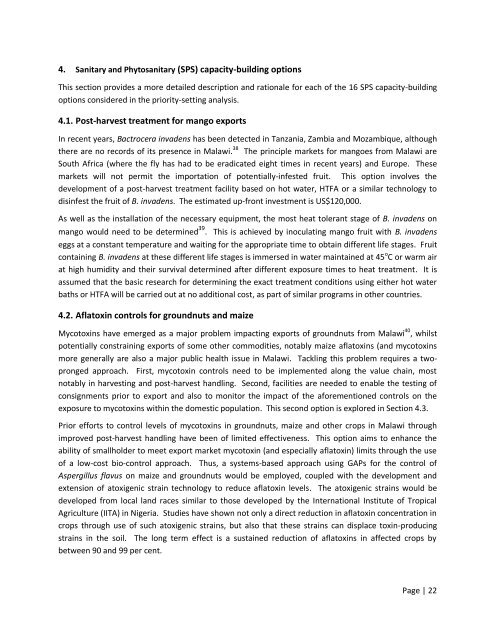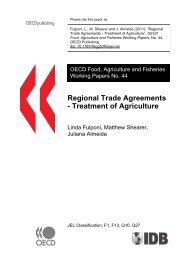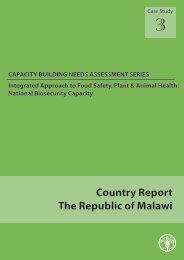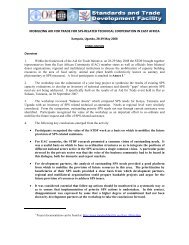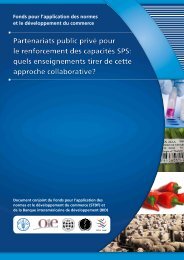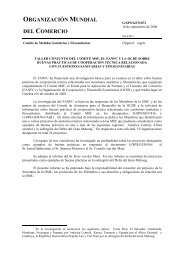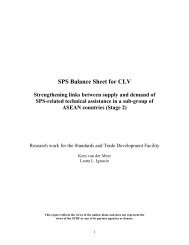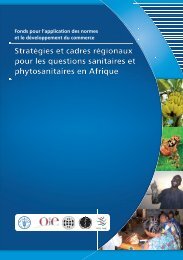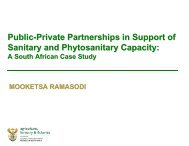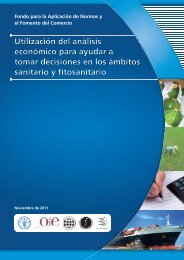MCDA Final Report Malawi - Standards and Trade Development ...
MCDA Final Report Malawi - Standards and Trade Development ...
MCDA Final Report Malawi - Standards and Trade Development ...
You also want an ePaper? Increase the reach of your titles
YUMPU automatically turns print PDFs into web optimized ePapers that Google loves.
4. Sanitary <strong>and</strong> Phytosanitary (SPS) capacity-building options<br />
This section provides a more detailed description <strong>and</strong> rationale for each of the 16 SPS capacity-building<br />
options considered in the priority-setting analysis.<br />
4.1. Post-harvest treatment for mango exports<br />
In recent years, Bactrocera invadens has been detected in Tanzania, Zambia <strong>and</strong> Mozambique, although<br />
there are no records of its presence in <strong>Malawi</strong>. 38 The principle markets for mangoes from <strong>Malawi</strong> are<br />
South Africa (where the fly has had to be eradicated eight times in recent years) <strong>and</strong> Europe. These<br />
markets will not permit the importation of potentially-infested fruit. This option involves the<br />
development of a post-harvest treatment facility based on hot water, HTFA or a similar technology to<br />
disinfest the fruit of B. invadens. The estimated up-front investment is US$120,000.<br />
As well as the installation of the necessary equipment, the most heat tolerant stage of B. invadens on<br />
mango would need to be determined 39 . This is achieved by inoculating mango fruit with B. invadens<br />
eggs at a constant temperature <strong>and</strong> waiting for the appropriate time to obtain different life stages. Fruit<br />
containing B. invadens at these different life stages is immersed in water maintained at 45 o C or warm air<br />
at high humidity <strong>and</strong> their survival determined after different exposure times to heat treatment. It is<br />
assumed that the basic research for determining the exact treatment conditions using either hot water<br />
baths or HTFA will be carried out at no additional cost, as part of similar programs in other countries.<br />
4.2. Aflatoxin controls for groundnuts <strong>and</strong> maize<br />
Mycotoxins have emerged as a major problem impacting exports of groundnuts from <strong>Malawi</strong> 40 , whilst<br />
potentially constraining exports of some other commodities, notably maize aflatoxins (<strong>and</strong> mycotoxins<br />
more generally are also a major public health issue in <strong>Malawi</strong>. Tackling this problem requires a twopronged<br />
approach. First, mycotoxin controls need to be implemented along the value chain, most<br />
notably in harvesting <strong>and</strong> post-harvest h<strong>and</strong>ling. Second, facilities are needed to enable the testing of<br />
consignments prior to export <strong>and</strong> also to monitor the impact of the aforementioned controls on the<br />
exposure to mycotoxins within the domestic population. This second option is explored in Section 4.3.<br />
Prior efforts to control levels of mycotoxins in groundnuts, maize <strong>and</strong> other crops in <strong>Malawi</strong> through<br />
improved post-harvest h<strong>and</strong>ling have been of limited effectiveness. This option aims to enhance the<br />
ability of smallholder to meet export market mycotoxin (<strong>and</strong> especially aflatoxin) limits through the use<br />
of a low-cost bio-control approach. Thus, a systems-based approach using GAPs for the control of<br />
Aspergillus flavus on maize <strong>and</strong> groundnuts would be employed, coupled with the development <strong>and</strong><br />
extension of atoxigenic strain technology to reduce aflatoxin levels. The atoxigenic strains would be<br />
developed from local l<strong>and</strong> races similar to those developed by the International Institute of Tropical<br />
Agriculture (IITA) in Nigeria. Studies have shown not only a direct reduction in aflatoxin concentration in<br />
crops through use of such atoxigenic strains, but also that these strains can displace toxin-producing<br />
strains in the soil. The long term effect is a sustained reduction of aflatoxins in affected crops by<br />
between 90 <strong>and</strong> 99 per cent.<br />
Page | 22


